Epidemics on Networks#
Mathematics of Epidemics on Networks by Kiss, Miller, and Simon (Springer, 2017).
Github: springer-math/Mathematics-of-Epidemics-on-Networks
Documentation: https://epidemicsonnetworks.readthedocs.io/en/latest/GettingStarted.html#quickstart-guide
import networkx as nx
import matplotlib.pyplot as plt
import EoN
!pip install EoN
Collecting EoN
Downloading EoN-1.1.tar.gz (113 kB)
|████████████████████████████████| 113 kB 167 kB/s eta 0:00:01
?25hRequirement already satisfied: networkx in /opt/anaconda3/lib/python3.7/site-packages (from EoN) (2.4)
Requirement already satisfied: numpy in /opt/anaconda3/lib/python3.7/site-packages (from EoN) (1.18.1)
Requirement already satisfied: scipy in /opt/anaconda3/lib/python3.7/site-packages (from EoN) (1.4.1)
Requirement already satisfied: matplotlib in /opt/anaconda3/lib/python3.7/site-packages (from EoN) (3.1.3)
Requirement already satisfied: decorator>=4.3.0 in /opt/anaconda3/lib/python3.7/site-packages (from networkx->EoN) (4.4.1)
Requirement already satisfied: cycler>=0.10 in /opt/anaconda3/lib/python3.7/site-packages (from matplotlib->EoN) (0.10.0)
Requirement already satisfied: python-dateutil>=2.1 in /opt/anaconda3/lib/python3.7/site-packages (from matplotlib->EoN) (2.8.1)
Requirement already satisfied: pyparsing!=2.0.4,!=2.1.2,!=2.1.6,>=2.0.1 in /opt/anaconda3/lib/python3.7/site-packages (from matplotlib->EoN) (2.4.6)
Requirement already satisfied: kiwisolver>=1.0.1 in /opt/anaconda3/lib/python3.7/site-packages (from matplotlib->EoN) (1.1.0)
Requirement already satisfied: six in /opt/anaconda3/lib/python3.7/site-packages (from cycler>=0.10->matplotlib->EoN) (1.14.0)
Requirement already satisfied: setuptools in /opt/anaconda3/lib/python3.7/site-packages (from kiwisolver>=1.0.1->matplotlib->EoN) (46.0.0.post20200309)
Building wheels for collected packages: EoN
Building wheel for EoN (setup.py) ... ?25ldone
?25h Created wheel for EoN: filename=EoN-1.1-py3-none-any.whl size=120820 sha256=886523083b30b925f17ff6d1e56a89ea29c66a495588b660f53c122757bcf946
Stored in directory: /Users/datalab/Library/Caches/pip/wheels/0b/c0/a4/d6001fd809cb84c027ada5c2ab3b6d1cb2e97fec3f9978eae7
Successfully built EoN
Installing collected packages: EoN
Successfully installed EoN-1.1
SIR Model#
N=10**5
G=nx.barabasi_albert_graph(N, 5) #create a barabasi-albert graph
tmax = 20
iterations = 5 #run 5 simulations
tau = 0.1 #transmission rate
gamma = 1.0 #recovery rate
rho = 0.005 #random fraction initially infected
# Simulations and Models
for counter in range(iterations): #run simulations
t, S, I, R = EoN.fast_SIR(G, tau, gamma, rho=rho, tmax = tmax)
if counter == 0:
plt.plot(t, I, color = 'k', alpha=0.3, label='Simulation')
plt.plot(t, I, color = 'k', alpha=0.3)
# plot the Pref mix EBCM
t, S, I, R = EoN.EBCM_pref_mix_from_graph(G, tau, gamma, rho=rho, tmax=tmax)
plt.plot(t, I, label = 'Pref mix EBCM', linewidth=5, dashes=[4, 2, 1, 2, 1, 2])
plt.xlabel('$t$')
plt.ylabel('Number infected')
plt.legend();
/opt/anaconda3/lib/python3.7/site-packages/IPython/core/pylabtools.py:132: UserWarning: Creating legend with loc="best" can be slow with large amounts of data.
fig.canvas.print_figure(bytes_io, **kw)

Now compare with ODE predictions.
Read in the degree distribution of G
use rho to initialize the various model equations.
There are versions of these functions that allow you to specify the initial conditions rather than starting from a graph.
#we expect a homogeneous model to perform poorly because the degree
#distribution is very heterogeneous
t, S, I, R = EoN.SIR_homogeneous_pairwise_from_graph(G, tau, gamma, rho=rho, tmax = tmax)
plt.plot(t, I, '-.', label = 'Homogeneous pairwise', linewidth = 5)
#meanfield models will generally overestimate SIR growth because they
#treat partnerships as constantly changing.
t, S, I, R = EoN.SIR_heterogeneous_meanfield_from_graph(G, tau, gamma, rho=rho, tmax=tmax)
plt.plot(t, I, ':', label = 'Heterogeneous meanfield', linewidth = 5)
#The EBCM model does not account for degree correlations or clustering
t, S, I, R = EoN.EBCM_from_graph(G, tau, gamma, rho=rho, tmax = tmax)
plt.plot(t, I, '--', label = 'EBCM approximation', linewidth = 5)
#the preferential mixing model captures degree correlations.
t, S, I, R = EoN.EBCM_pref_mix_from_graph(G, tau, gamma, rho=rho, tmax=tmax)
plt.plot(t, I, label = 'Pref mix EBCM', linewidth=5, dashes=[4, 2, 1, 2, 1, 2])
plt.xlabel('$t$')
plt.ylabel('Number infected')
plt.legend();
# plt.savefig('SIR_BA_model_vs_sim.png')
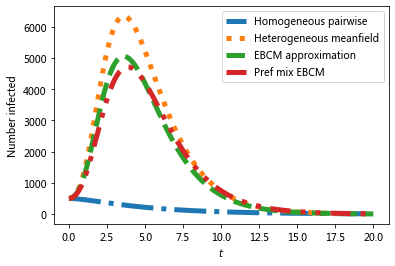
The preferential mixing version of the EBCM approach provides the best approximation to the (gray) simulated epidemics.
We now move on to SIS epidemics:
SIS#
#Now run for SIS.
# Simulation is much slower so need smaller network
N=10**4
G=nx.barabasi_albert_graph(N, 5) #create a barabasi-albert graph
# simulations
for counter in range(iterations):
t, S, I = EoN.fast_SIS(G, tau, gamma, rho=rho, tmax = tmax)
if counter == 0:
plt.plot(t, I, color = 'k', alpha=0.3, label='Simulation')
plt.plot(t, I, color = 'r', alpha=0.3)
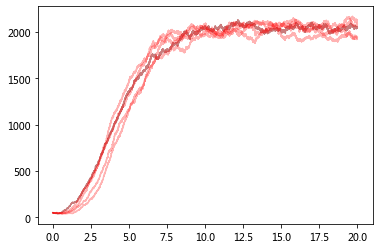
Now compare with ODE predictions.
Read in the degree distribution of G
and use rho to initialize the various model equations.
There are versions of these functions that allow you to specify the initial conditions rather than starting from a graph.
#we expect a homogeneous model to perform poorly because the degree
#distribution is very heterogeneous
t, S, I = EoN.SIS_homogeneous_pairwise_from_graph(G, tau, gamma, rho=rho, tmax = tmax)
plt.plot(t, I, '-.', label = 'Homogeneous pairwise', linewidth = 5)
t, S, I = EoN.SIS_heterogeneous_meanfield_from_graph(G, tau, gamma, rho=rho, tmax=tmax)
plt.plot(t, I, ':', label = 'Heterogeneous meanfield', linewidth = 5)
t, S, I = EoN.SIS_compact_pairwise_from_graph(G, tau, gamma, rho=rho, tmax=tmax)
plt.plot(t, I, '--', label = 'Compact pairwise', linewidth = 5)
plt.xlabel('$t$')
plt.ylabel('Number infected')
plt.legend();
#plt.savefig('SIS_BA_model_vs_sim.png')
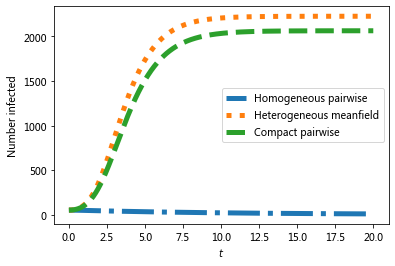
# Which model is better?
for counter in range(iterations):
t, S, I = EoN.fast_SIS(G, tau, gamma, rho=rho, tmax = tmax)
if counter == 0:
plt.plot(t, I, color = 'k', alpha=0.3, label='Simulation')
plt.plot(t, I, color = 'k', alpha=0.3)
t, S, I = EoN.SIS_heterogeneous_meanfield_from_graph(G, tau, gamma, rho=rho, tmax=tmax)
plt.plot(t, I, ':', label = 'Heterogeneous meanfield', linewidth = 5)
t, S, I = EoN.SIS_compact_pairwise_from_graph(G, tau, gamma, rho=rho, tmax=tmax)
plt.plot(t, I, '--', label = 'Compact pairwise', linewidth = 5)
plt.xlabel('$t$')
plt.ylabel('Number infected')
plt.legend();
/opt/anaconda3/lib/python3.7/site-packages/IPython/core/pylabtools.py:132: UserWarning: Creating legend with loc="best" can be slow with large amounts of data.
fig.canvas.print_figure(bytes_io, **kw)

Visualizing disease spread in a lattice network#
SIS#
N=10**3
G=nx.barabasi_albert_graph(N, 5) #create a barabasi-albert graph
#we'll initially infect those near the middle
#initial_infections = [(u,v) for (u,v) in G if 45<u<55 and 45<v<55]
sim = EoN.fast_SIS(G, 1.0, 1.0, #initial_infecteds = initial_infections,
return_full_data=True, tmax = 10)
pos = {node:node for node in G}
sim.set_pos(pos)
sim.node_history(1)
([0,
0.6480038096909582,
2.878859186164565,
2.9153163284908272,
3.5092942025944662,
3.568385141191922,
3.953701848185159,
4.130846668005088,
4.647110703032882,
4.655021347166778,
5.8659601120198435,
5.930463898298382,
6.224253021645784,
6.227291277319202,
6.264444402330622,
6.320875535226936,
6.758903198213538,
6.783741136385256,
8.001029042237164,
8.031476668187205,
8.375831529735354,
8.409966778198903,
8.749362275400193,
8.765325875433902],
['S',
'I',
'S',
'I',
'S',
'I',
'S',
'I',
'S',
'I',
'S',
'I',
'S',
'I',
'S',
'I',
'S',
'I',
'S',
'I',
'S',
'I',
'S',
'I'])
#each node is (u,v) where 0<=u,v<=99
G = nx.grid_2d_graph(100,100)
#we'll initially infect those near the middle
initial_infections = [(u,v) for (u,v) in G if 45<u<55 and 45<v<55]
sim = EoN.fast_SIS(G, 1.0, 1.0, initial_infecteds = initial_infections,
return_full_data=True, tmax = 10)
pos = {node:node for node in G}
sim.set_pos(pos)
sim.display(0, node_size = 4); #display time 6
#plt.savefig('SIS_2dgrid.png')
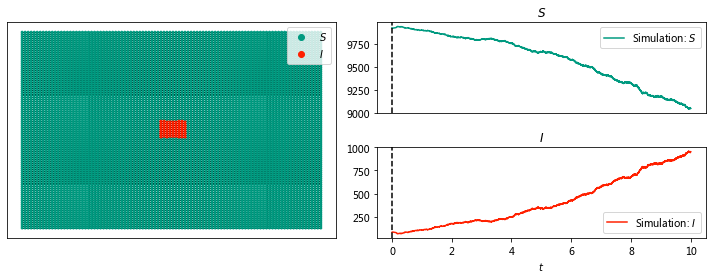
sim.display(1, node_size = 4); #display time 6
#plt.savefig('SIS_2dgrid.png')

sim.display(2, node_size = 4);
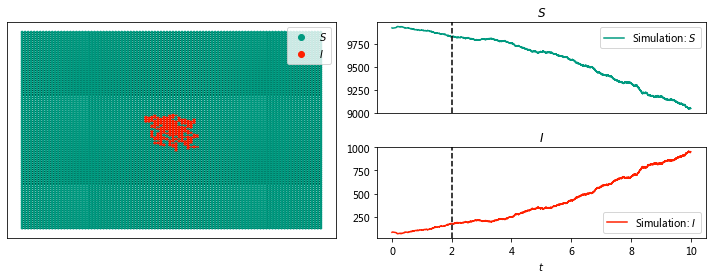
sim.display(3, node_size = 4);
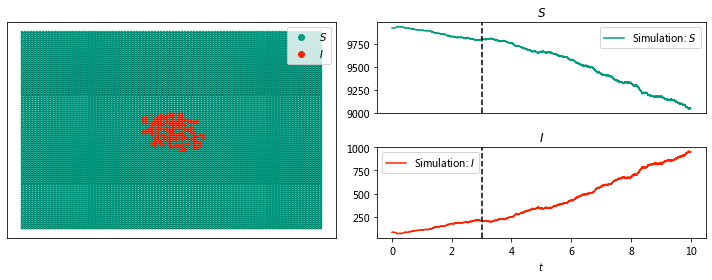
sim.display(10, node_size = 4);
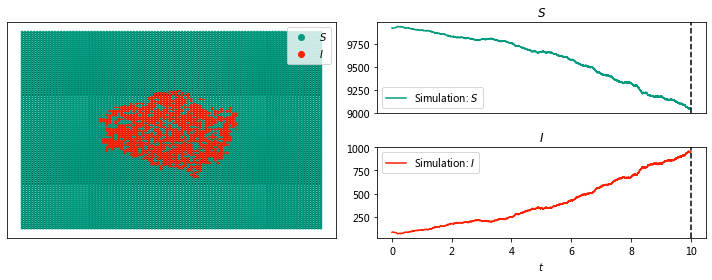
ani_sis=sim.animate(ts_plots=['S', 'I'], node_size = 4)
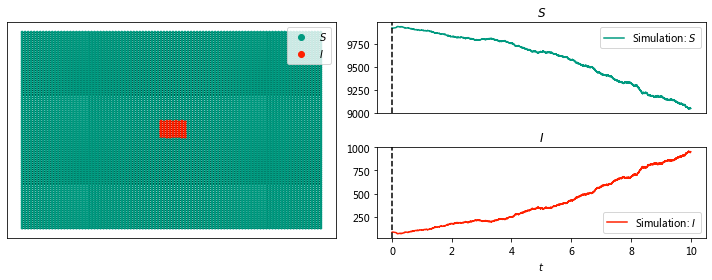
# brew intall ffmpeg
from IPython.display import display, HTML
display(HTML(ani_sis.to_html5_video()))
SIR#
import networkx as nx
import EoN
import matplotlib.pyplot as plt
G = nx.grid_2d_graph(100,100) #each node is (u,v) where 0<=u,v<=99
#we'll initially infect those near the middle
initial_infections = [(u,v) for (u,v) in G if 45<u<55 and 45<v<55]
sim = EoN.fast_SIR(G, 2.0, 1.0, initial_infecteds = initial_infections,
return_full_data=True, tmax = 10)
pos = {node:node for node in G}
sim.set_pos(pos)
ani=sim.animate(ts_plots=['I', 'SIR'], node_size = 4)
ani.save('../vis/SIR_2dgrid.mp4', fps=5, extra_args=['-vcodec', 'libx264'])
%%HTML
<div align="middle">
<video width="80%" controls>
<source src="../vis/SIR_2dgrid.mp4" type="video/mp4">
</video></div>
from IPython.display import display, HTML
display(HTML(ani.to_html5_video()))
# from ipywidgets import interact, fixed
# interact(sim.display, time=[0, 10], node_size = 4);
Play with many more examples.#
https://epidemicsonnetworks.readthedocs.io/en/latest/Examples.html

